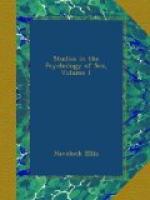fully ten months in each year the deer has all
he can do to live without extra exertion incident
to rutting. Soon after the autumn rains commence
vegetation becomes more luxurious, the antlers of
the male and new suits of hair for both are fully
grown, heat of the summer is gone, food and drink
are plentiful everywhere, the fawns are weaned,
and both sexes are in the very finest condition.
Then, and then only, in the whole year, comes the rut,
which, to them as to most other animals, means
an unwonted amount of physical exercise besides
the everyday runs for life from their natural
enemies, and an unusual amount of energy is used up.
If a doe dislikes the attention of a special buck,
miles of racing result. If jealous males
meet, furious battles take place. The strain
on both sexes could not possibly be endured at any
other season of the year. With approach of
cold weather, climatic deprivations and winter
dangers commence and rut closes. In all wild
animals, rut occurs only when the climatic and other
conditions favor the highest physical development.
This law holds good in all wild birds, for it
is then only that they can stand the strain incident
to love-making. The common American crow is a
very good study. In the winter he travels
around the ricefields of the South, leading a
tramp’s existence in a country foreign to him,
and to which he goes only to escape the rigors of the
northern climate. For several weeks in the
spring he goes about the fields, gathering up
the worms and grubs. After his long flight
from the South he experiences several weeks of an almost
ideal existence, his food is plentiful, he becomes
strong and hearty, and then he turns to thoughts
of love. In the pairing season he does more
work than at any other time in the year: fantastic
dances, racing and chasing after the females, and
savage fights with rivals. He endures more
than would be possible in his ordinary physical
state. Then come the care of the young and
the long flights for water and food during the drought
of the summer. After the molt, autumn finds
him once more in flock, and with the first frosts
he is off again to the South. In the wild state,
rut is the capstone of perfect physical condition.”
(A.W. Johnstone, “The Relation of Menstruation
to the other Reproductive Functions,” American
Journal of Obstetrics, vol. xxxii, 1895.)
Wiltshire ("Lectures on the Comparative Physiology of Menstruation,” British Medical Journal, March, 1888) and Westermarck (History of Human Marriage, Chapter II) enumerate the pairing season of a number of different animals.
With regard to the breeding seasons of monkeys, little seems to be positively known. Heape made special inquiries with reference to the two species whose sexual life he investigated. He was informed that Semnopithecus entellus breeds twice a year, in April and in October. He accepts Aitcheson’s statement that the Macacus




